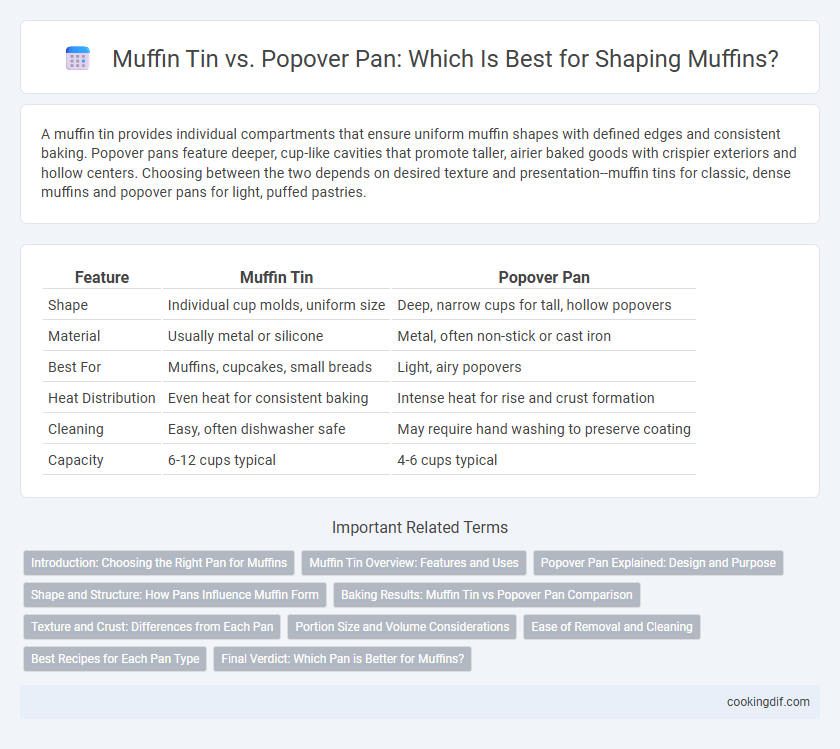A muffin tin provides individual compartments that ensure uniform muffin shapes with defined edges and consistent baking. Popover pans feature deeper, cup-like cavities that promote taller, airier baked goods with crispier exteriors and hollow centers. Choosing between the two depends on desired texture and presentation--muffin tins for classic, dense muffins and popover pans for light, puffed pastries.
Table of Comparison
| Feature | Muffin Tin | Popover Pan |
|---|---|---|
| Shape | Individual cup molds, uniform size | Deep, narrow cups for tall, hollow popovers |
| Material | Usually metal or silicone | Metal, often non-stick or cast iron |
| Best For | Muffins, cupcakes, small breads | Light, airy popovers |
| Heat Distribution | Even heat for consistent baking | Intense heat for rise and crust formation |
| Cleaning | Easy, often dishwasher safe | May require hand washing to preserve coating |
| Capacity | 6-12 cups typical | 4-6 cups typical |
Introduction: Choosing the Right Pan for Muffins
Muffin tins offer uniform cavity shapes ideal for consistently sized muffins with defined edges, promoting even baking and easy portion control. Popover pans feature deeper, taller wells that encourage batter expansion, resulting in muffins with a lighter, airy texture and irregular crust. Selecting between a muffin tin and a popover pan depends on the desired muffin shape, texture, and presentation style for optimal baking results.
Muffin Tin Overview: Features and Uses
Muffin tins feature multiple evenly spaced cup-shaped molds that provide uniform heat distribution, ideal for baking individual muffins and cupcakes with consistent shape and size. Constructed from materials like aluminum or silicone, they ensure non-stick surfaces and easy removal, enhancing convenience and durability. Common uses extend beyond muffins to include mini quiches, frittatas, and other bite-sized baked goods requiring precise portioning and shape retention.
Popover Pan Explained: Design and Purpose
A popover pan features deep, narrow cups designed to support batter expansion and create tall, airy pastries with crisp, golden crusts. Its heavy-gauge metal construction ensures even heat distribution, promoting the distinctive puffing effect characteristic of popovers. Unlike a muffin tin with wider, shallower cavities, the popover pan's design directs steam to lift the batter upwards rather than outwards, optimizing shape and texture.
Shape and Structure: How Pans Influence Muffin Form
Muffin tins create uniform, dome-shaped muffins with defined edges by using individual compartments that support batter rise evenly. Popover pans, featuring deeper, cylindrical wells, encourage taller, hollow-centered baked goods with crisp exteriors and light, airy structures. The choice between these pans directly impacts muffin shape and crumb texture, with tins producing classic muffins and popover pans yielding more irregular, airy forms.
Baking Results: Muffin Tin vs Popover Pan Comparison
Muffin tins create evenly shaped, uniform muffins with defined edges, promoting consistent browning and a tender crumb texture. Popover pans, featuring deeper, open cups, encourage a lighter, airier rise resulting in hollow, puffed pastries with a crisp exterior. The choice between muffin tin and popover pan directly impacts the final muffin structure, texture, and crust quality.
Texture and Crust: Differences from Each Pan
Muffin tins produce evenly shaped baked goods with a uniform, tender crumb and a slightly crisp outer edge due to their deep, individual wells that allow heat to circulate evenly. Popover pans feature taller, narrower cups that promote a puffed, airy texture with a thin, crisp crust, resulting from higher steam circulation and less contact with the metal surface. The choice between a muffin tin and popover pan significantly impacts the texture and crust, with tins yielding a denser, moister result and popover pans delivering a lighter, hollow interior and crispier exterior.
Portion Size and Volume Considerations
Muffin tins provide uniform portion sizes with individual cups that control batter volume, resulting in consistent, evenly baked muffins. Popover pans feature deeper, larger wells that allow batter to expand significantly, yielding taller, airier servings with greater volume. Choosing between the two depends on desired portion control versus dramatic volume and shape.
Ease of Removal and Cleaning
Muffin tins typically feature nonstick coatings and individual cups, making it easier to remove muffins without sticking and simplifying the cleaning process. Popover pans, with their deeper wells and often less nonstick surfaces, can require more effort to release delicate popovers and may need soaking before cleaning to remove baked-on batter. Overall, muffin tins offer superior ease of removal and quicker cleanup compared to popover pans.
Best Recipes for Each Pan Type
Muffin tins excel at shaping uniform, single-serving baked goods like classic blueberry muffins and chocolate chip muffins, providing consistent rise and even browning. Popover pans create airy, hollow-centered treats such as traditional popovers and Yorkshire puddings, where the individual cups support the batter's expansion for a crisp exterior and soft interior. Best recipes for muffin tins emphasize dense, moist textures, while popover pans are ideal for light, puffy pastries that rely on steam for their signature rise.
Final Verdict: Which Pan is Better for Muffins?
A muffin tin offers uniform shaping and consistent portion sizes, resulting in evenly baked muffins with a classic round shape. Popover pans create taller, lighter, and airier muffins due to their deeper cups and unique design, but may yield less uniformity in size. For traditional muffins, a muffin tin is better, while popover pans suit recipes aiming for a delicate, hollow texture.
Muffin tin vs Popover pan for shaping Infographic

 cookingdif.com
cookingdif.com